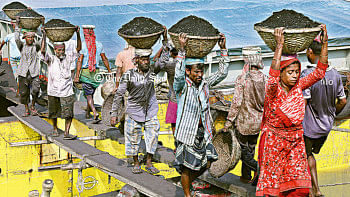Invoking the Spirit of Durga

As written in the pages of History
The first grand worship of Goddess Durga in recorded history is said to have been celebrated in the late 1500s. Folklores say the landlords, or zamindar, of Dinajpur and Malda initiated the first Durga Puja in Bengal.
According to another source, Raja Kangshanarayan of Taherpur or Bhabananda Mazumdar of Nadiya organised the first Sharadiya or Autumn Durga Puja in Bengal in 1606.
Officially, it is stated that the first grand Puja was organised by Raja Nabakrishna Deb of Calcutta in honour of Lord Clive in 1757. Earlier, the puja was organised only by the rich families who had the resources to spend on elaborate worship. In the late 19th and 20th century, the middle class in Calcutta and East Bengal brought about a transformation and started the tradition of Community Puja or Sarbojanin Puja.
While we are familiar with the celebrations being held in autumn, Shardiya Puja originally was celebrated in spring as Basanti Durga Puja. The legend of the first Shardiya Durga Puja lies with Prince Rama's invocation of the goddess Durga before going to war with the demon king Ravana.

To grant him victory in the upcoming battle, Prince Rama, first invoked the 'Mahishasura Mardini' or the slayer of the buffalo-demon, by offering 108 blue lotuses and lighting 108 lamps.
This autumnal ritual was different from the conventional Basanti Durga Puja of that time. This is also the reason this Puja is known as 'akal-bodhan' or out-of-season ('akal') worship ('bodhan'). Following Prince Rama's victory, the people too started celebrating the Shardiya Durga Puja and continue doing so. While the Basanti Puja is celebrated with much gusto in the eastern parts of India and especially in West Bengal, the Shardiya Puja is the one we are all familiar with as Durga Puja.
The inevitable variations through time
Each and every celebration around the world is undergoing change. While the core celebrations are not prone to any transformations, the way of celebrating does show the impact of time. Talking to Nityananda Chakraborty, president of the Sri Sri Geeta Sangha Bangladesh, on this change- he mentioned that with the constant onslaught of Westernisation, often the true essence becomes diluted. He also mentions that over the last three or four years, a touch of materialism has breached the Durga Puja celebrations.
The young and youthful devotees however are participating in the Durga Puja celebrations more than ever. Furthermore, they are discussing the origins and coming forward with their questions. He believes that this is a much-welcomed sight.
The number of Pujas being held around the country is also increasing. This shows that the devotees are marking numbers with quality and shows their urge for peace and enlightenment.
While the young and the old are both flocking to the temples, Nityananda Chakraborty notes that they need to read more. As they are dependent on peers for information, it will help them all if they reverted to scriptures every once in a while.
From a philosophical standpoint, Devi Durga is a form of Shakti (or energy), and the Dhaka scene is not the only representative of reaching this Shakti. The rural communities around the country too are striving to join the festivities. While materialism is a matter of concern, the economic improvement shows starting from the clothes the devotees adorn themselves in to the Dakkhina that is given during the occasion.
Celebrating in harmony
Tomalika Biswas, a final year student at Eden studying in Sociology, recalls stories of the arrival of the of Durga from her maternal grandfather who lived in Jessore. Hay mixed with clay transforming into the goddess — the idol makers almost seemed like drawing in the spirit of the Devi as the Protima and her ensemble came into being. She herself feels a certain pull as the Dashami arrives and it is time to say goodbye to the Devi. Over the years, she has taken her friends from various walks of belief to the festivities and has partaken in theirs as well.
One year ago, she remembers how her friends had come together during the Puja just as she had gone to their celebrations. At a time of crisis and an all invading negative vibe, this togetherness was a source of calm and serenity for her and her friends. For this year's Durga Puja, she visualises a balance of beliefs and energy that will dispel the evil and the ominous forces as the Devi Durga had eradicated the Mahishashura.
Since times of old, the sky, the stars and other celestial bodies, the land and the rivers were the centre of all beliefs in this region. As a riverine country that blooms and blossoms at the slightest hint of rain water, the spirits of the land have surely blessed the people. Amidst the rising crisis and all that is evil, Devi Durga visits this delta every year and brings with her the force to cleanse the evil that encases the land. This energy is resonated throughout her devotees as they prepare to welcome her once again.
By Iris Farina
Photo: LS Archive/Sazzad Ibne Sayed
Special thanks to Nityananda Chakraborty, for providing insight on the changing trends in Durga Puja.


 For all latest news, follow The Daily Star's Google News channel.
For all latest news, follow The Daily Star's Google News channel. 



Comments